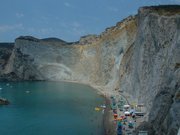Ponza
|
|
Ponza (Isola Di Ponza) is the largest of the Italian Pontine islands archipelago, located 33 km south of Cape Circeo in the Tyrrhenian Sea. Other Pontine islands include Gavi, Palmarola, Zannone, Ventotene and Santo Stefano Island. The Pontine Archipelago is at the Southern edge of the Italian Riviera.
| Contents |
Geography
Pontine_Islands_map.png
Ponza is the largest in the Pontine Islands, which are the remains of extinct volcanos, with a surface area is 7.3 square kilometers. It is a crescent shaped island with one large beach called Spiaggia di Chiaia di Luna (Half Moon Beach) and a few small beaches and has a mostly rocky coast made of kaolin and tufa rock. It has many odd natural rock formations, one looks like a monk, another looks like a giant pair of pants (Arco Naturale O Spaccapolpi), another looks like a patch of flowers or mushrooms.
The island is famed for its grottos, which were created by Etruscans. It has the Serpents Grotto and the Roman Gallery which is a Roman tunnel to connect the town of Ponza to the large beach called Chiaia di Luna on its west side. There are Egypitian, Cannanite, Greek, and Phoenician Necropoli ruins. It has a small town named Ponza and another one named Santa Maria and a few smaller towns. Ponza is often confused with nearby islands like Ischia and Capri, except Ponza has no active volcanism.
Economy
The town of Ponza is a fishing and boating port with a large dock that can accommodate huge ships. Its biggest business is tourism followed by boatbuilding, boat repair and fishing. It is accessible by small car by ferry and pedestriand may travel to the mainland by high speed Aliscafi - Hydrofoil Boats. The sea there is a distinct geenish blue. Ferries visit Ponza from Naples (Napoli) and Formia(Italia) and Hydroplane boats visit from Anzio, Italy.
The kaolin mines that was at the northern end of the island has shut down. Kaolin is used in making Kaopectate Koalin-Pectate medicine. The island has many archeological ruins all over and a road that goes from north to south.
History
Ponza was named after Roman governor Pontius Pilate, the man who tried Jesus for heresy. The island was inhabited from neolithic through Roman times.
In ancient times the island was called Tyrrhenia. Legend says that Ponza is what is left of the lost island of Tyrrhenia, which somewhat resembles the Atlantis legend. Ponza is said to have been connected to the mainland by a narrow strip of land, which sunk into the sea with most of the island below the water, with the parts remaining above sea level. According to legend, there was a large city on the ancient island. There has been significant archeological progress recently that shows this may be true. For example, it was discovered that the harbor floor of Pozzuoli had sunk and risen several times in the last 3000 years, revealing sunken Roman temples.
The island used to be heavily forested in ancient times but the forest is gone and the hills are covered with man made terraces that resemble the terraces of Peru. Crops are grown on these terraces like grapes for wine and cactus pears and fig trees. There are Etruscan ruins all over and "Il Mommio or Mitreo" (Mummy or Mitre) is a 3000 year old marble statue that was found in the harbor. It is the oldest statue of its kind. It now is in a museum in Napoli.
During Roman times, huge palaces for royalty like the Palazzo Giulia (Julia's Palace) where the Emperor Augustus' daughter lived in exile for adultery.
Ponza was abandoned during the middle ages due to constant raids by Saracens and pirates. During the 18th century, the Kingdom of Naples re-colonized the island. Today the island serves as a major tourist attraction with big sandy beaches like Chiaia di Luna or Half Moon Beach.
The island has been captured by the Spanish, English, Greek, French, Moors, Libyans, Egyptians, Phoenicians, and Cannanites.
It became part of The Kingdom of Italy in the mid-1800s and it is now part of The Republic of Italy. Located in a beautiful landscape, the island's isolation destined it to serve as a penal colony by various regimes. During the two decades of fascism the island, together with the nearby Ventotene, served as a prison for political opposents of Mussolini's regime.
The island is known for the tragic story of Lucia Rosa who threw herself into the Tyrrhenian Sea rather than being forced to marry a man she did not want. She is viewed by many women around the world as a martyr for womens' rights and symbol for human rights.
A few years ago Engineers working on an ancient Roman tunnel that connected the harbor part of Ponza to Santa Maria, used explosives to dig a conduit nearby. They were supposed to use a chisel. The explosives shock shattered and destroyed this 2100 year old Roman Gallery Tunnel. Residents now must travel far out of the way road to go back and forth or use a boat.
External links
- Satellite Map of Island Of Ponza (http://www.terraserver.com/imagery/image_gx.asp?cpx=12.967180152379198&cpy=40.90457177642796&res=16&provider_id=320&t=pan)
- Official Ponza website (Italian) (http://www.ponza.it)
- Aerial image of Ponza Island (http://www.crazyhorse.it/images/ponza.jpg)
- Italian Wikipedia article on Ponza (http://it.wikipedia.org/wiki/Ponza)it:Ponza (isola)

